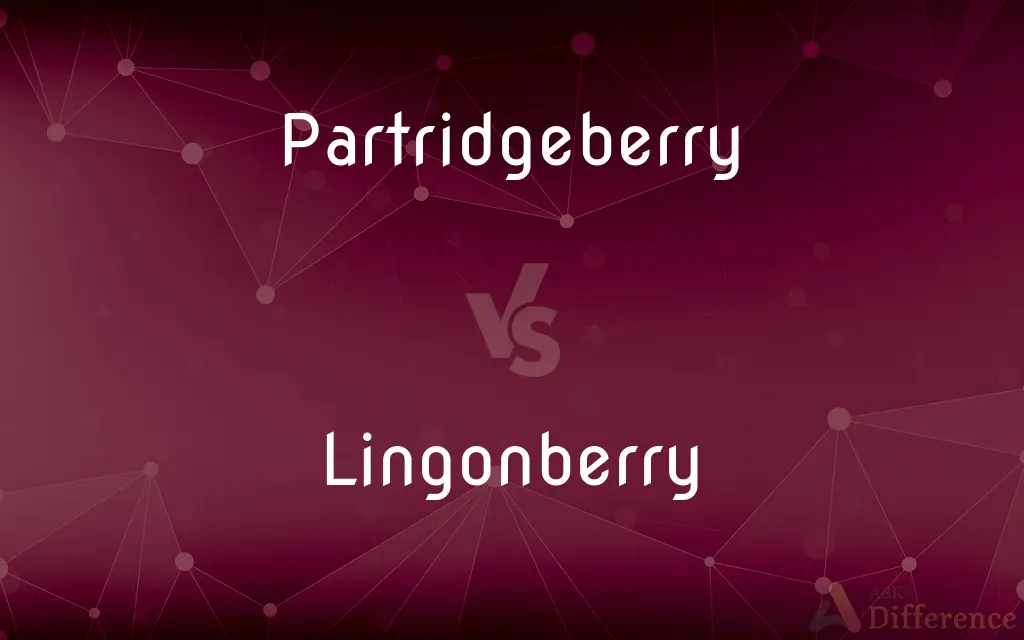Partridgeberry vs. Lingonberry — What's the Difference?
By Tayyaba Rehman & Maham Liaqat — Updated on April 4, 2024
Partridgeberry is a low-growing, evergreen vine with edible, red berries, while Lingonberry, also bearing edible red berries, is a larger, more cold-tolerant shrub.

Difference Between Partridgeberry and Lingonberry
Table of Contents
ADVERTISEMENT
Key Differences
Partridgeberry, known scientifically as Mitchella repens, thrives in the woodland floors of North America, bearing small, red, edible berries that are mildly sweet. Whereas Lingonberry, Vaccinium vitis-idaea, is native to the Arctic tundra and boreal forests across the Northern Hemisphere, producing tart, red berries that are rich in antioxidants and commonly used in Scandinavian cuisine.
Partridgeberry plants have a distinctive growth habit, forming dense mats on the forest floor with small, paired flowers that lead to the formation of a single berry from two flowers. On the other hand, Lingonberries grow on short, evergreen shrubs with oval, leathery leaves and bear solitary flowers that each produce a single, tart berry known for its culinary and medicinal uses.
The berries of the Partridgeberry are often used in native North American cuisine for teas, jams, and medicinal purposes, valued for their mild flavor and nutritional content. Meanwhile, Lingonberries are a staple in Northern European diets, used in a variety of dishes from jams and juices to sauces, thanks to their sharp, distinct flavor and health benefits.
Partridgeberry is commonly found as a decorative ground cover in gardens due to its attractive foliage and berries, as well as its low maintenance requirements. Conversely, Lingonberry, while also used for landscaping, is more often cultivated on a larger scale for its fruit, which is harvested commercially and widely available in supermarkets, especially in Northern Europe.
Comparison Chart
Scientific Name
Mitchella repens
Vaccinium vitis-idaea
ADVERTISEMENT
Habitat
Woodland floors in North America
Arctic tundra and boreal forests across the Northern Hemisphere
Berry Flavor
Mildly sweet
Tart and sharp
Culinary Uses
Teas, jams, medicinal purposes
Jams, juices, sauces, culinary and medicinal uses
Growth Habit
Low-growing vine, forms dense mats, decorative ground cover
Short, evergreen shrub, cultivated commercially for fruit
Compare with Definitions
Partridgeberry
Partridgeberry has been used traditionally for medicinal purposes.
Native tribes used Partridgeberry to ease childbirth and menstrual pain.
Lingonberry
Its berries are used in various culinary applications.
From sauces to desserts, Lingonberries add a tart, refreshing flavor.
Partridgeberry
It produces small, edible, red berries that are mildly sweet.
The Partridgeberry's fruit is a treat in native American teas and desserts.
Lingonberry
The berries are known for their high antioxidant content.
Consuming Lingonberries is believed to offer numerous health benefits.
Partridgeberry
Partridgeberry is a low-growing, evergreen vine ideal for ground cover.
Gardeners love Partridgeberry for its ability to cover ground elegantly.
Lingonberry
Lingonberry is a hardy, evergreen shrub that thrives in cold climates.
Lingonberries flourish in the harsh conditions of the Arctic tundra.
Partridgeberry
Its dark green, glossy leaves and red berries make it attractive year-round.
The evergreen leaves of Partridgeberry add beauty to winter gardens.
Lingonberry
Produces tart, red berries rich in antioxidants.
Lingonberry jam is a staple in Scandinavian diets, prized for its health benefits.
Partridgeberry
Thrives in the woodland floors of North America.
You'll find Partridgeberry carpeting the forest floors across eastern North America.
Lingonberry
Cultivated on a larger scale for its fruit.
Lingonberry farms in Northern Europe supply berries to markets worldwide.
Partridgeberry
A creeping evergreen perennial plant (Mitchella repens) of eastern North America, having small white paired flowers and scarlet berries. Also called twinberry.
Lingonberry
A low creeping evergreen shrub (Vaccinium vitis-idaea), native to northern North America and Eurasia and having drooping clusters of small white or pinkish flowers.
Partridgeberry
Any of various plants, including
Lingonberry
The edible red berry of this plant, used to make sauces, jams, and preserves. In both senses also called cowberry, mountain cranberry.
Partridgeberry
Squaw vine, Mitchella repens
Lingonberry
A berry-bearing shrub, Vaccinium vitis-idaea, native to the cool temperate areas of the Northern Hemisphere.
Partridgeberry
Teaberry, Gaultheria procumbens
Lingonberry
The berry of this shrub.
Partridgeberry
(Newfoundland and Cape Breton Island) lingonberry, Vaccinium vitis-idaea
Lingonberry
Low evergreen shrub of high north temperate regions of Europe and Asia and America bearing red edible berries
Partridgeberry
The berry of such a plant.
Lingonberry
Tart red berries similar to American cranberries but smaller
Partridgeberry
Creeping woody plant of eastern North America with shiny evergreen leaves and scarlet berries
Common Curiosities
What is Partridgeberry?
Partridgeberry is a low-growing vine with edible red berries, native to North America.
Where do Partridgeberry plants thrive?
They thrive on woodland floors across North America.
Is Partridgeberry used in medicine?
Yes, it has been traditionally used for medicinal purposes by native tribes.
What is Lingonberry?
Lingonberry is a cold-tolerant, evergreen shrub with tart, red berries, common in the Northern Hemisphere.
How are Partridgeberry and Lingonberry berries used?
Partridgeberry berries are used in teas and jams, while Lingonberry berries are used in a wide range of culinary dishes.
How often do Lingonberries produce fruit?
Lingonberries can produce fruit twice a year in the right conditions.
Where are Lingonberries found?
In the Arctic tundra and boreal forests of the Northern Hemisphere.
Can you eat Partridgeberry berries raw?
Yes, Partridgeberry berries are edible and can be eaten raw, though they are mildly sweet.
Are Lingonberries good for you?
Yes, Lingonberries are rich in antioxidants and have several health benefits.
What's the difference in flavor between Partridgeberry and Lingonberry berries?
Partridgeberry berries are mildly sweet, whereas Lingonberry berries are tart and sharp.
How do you cultivate Lingonberries?
Lingonberries require cold climates and are often commercially cultivated for their fruit.
Do Lingonberries need a lot of sunlight?
Lingonberries prefer bright, indirect light or partial shade.
Can Partridgeberry be used as a ground cover?
Yes, it is an attractive ground cover due to its evergreen nature and red berries.
Are Partridgeberry plants easy to care for?
Yes, they are low maintenance and ideal for garden ground cover.
What are the health benefits of Lingonberries?
They are known for their antioxidant properties, which can contribute to heart health and lower inflammation.
Share Your Discovery

Previous Comparison
Lobby vs. Foyer
Next Comparison
Marry vs. MerryAuthor Spotlight
Written by
Tayyaba RehmanTayyaba Rehman is a distinguished writer, currently serving as a primary contributor to askdifference.com. As a researcher in semantics and etymology, Tayyaba's passion for the complexity of languages and their distinctions has found a perfect home on the platform. Tayyaba delves into the intricacies of language, distinguishing between commonly confused words and phrases, thereby providing clarity for readers worldwide.
Co-written by
Maham Liaqat















































